The Ankersmid Cell Modules
are used to introduce sample for analysis with the EyeTech. Different cell
types are presently available for various types of materials and
preparations.
Each Cell Module has a
built-in detector. Cells are easily installed and removed from the system
with a bolt and a cable connector; this provides the ability to rapidly
change cells when analyzing various materials.
All Cell Modules are designed
to optimize the conditions of analysis for a particular material. Based on
the nature of the material, the user can choose to analyze the sample in
any of the following forms: as dry powder, in a liquid medium, or as an
aerosol.
|
ACM-101 Magnetic
Stirring Cell
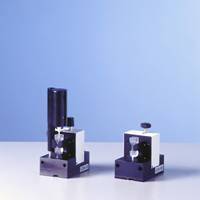 The ACM-101 Magnetic Stirrer
Cell Module is used for general analysis of liquid-borne particulates.
Sample volumes from 1.5 ml to 3.5 ml are used. Only milligram quantities
of a sample are required. Standard disposable plastic, or glass cuvettes
are used, with a special magnetic stirrer situated at the bottom of the
cuvette. Caution must be exercised when using solvents as media, to
prevent damage to cuvettes or other parts of the measurement
area. The ACM-101 Magnetic Stirrer
Cell Module is used for general analysis of liquid-borne particulates.
Sample volumes from 1.5 ml to 3.5 ml are used. Only milligram quantities
of a sample are required. Standard disposable plastic, or glass cuvettes
are used, with a special magnetic stirrer situated at the bottom of the
cuvette. Caution must be exercised when using solvents as media, to
prevent damage to cuvettes or other parts of the measurement
area.
Particle concentrations from
1,000 to 100 million particles per cc. may be measured; however, this Cell
Module may not be appropriate for measurement of:
1.
Very dense or large particles
which settle rapidly.
2.
Magnetic particles which are
attracted to the magnetic stirrer.
3.
Very delicate particles,
which may be ground up by the magnetic stirrer.

ACM-102 Mechanical
Stirring Cell
The ACM-102 Mechanical
Stirring Cell Module uses the same cuvette as the ACM-101, but
incorporates a propeller inserted from the top of the cuvette for stirring
the mixture. This Cell Module is recommended for measuring magnetic
particles.
|
ACM-104 Liquid
Flow Cell
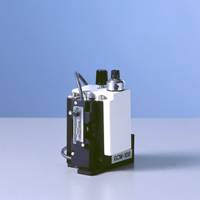 The ACM-104 Liquid Flow Cell
Module facilitates analysis of liquid borne particles which are propelled
through the cell by an external pump. Large volumes of liquid can be
pumped through the cell one way, or re-circulated (recommended when a
large amount of material is necessary, to obtain a representative
sample). The ACM-104 Liquid Flow Cell
Module facilitates analysis of liquid borne particles which are propelled
through the cell by an external pump. Large volumes of liquid can be
pumped through the cell one way, or re-circulated (recommended when a
large amount of material is necessary, to obtain a representative
sample).
The type of pump used is
determined by the material to be analyzed, and the nature of the liquid
medium used.
The ACM-104 is used for in
on-line applications, for monitoring the particulate content of continuous
flow processes as well as for the measurement of heavy or dense particles,
which can be maintained in uniform suspension by the action of a pump. The
ACM-104 may not be appropriate for liquid volumes of less than 20ml, or
for mixtures of particles with a high tendency to aggregate and clog the
cell or tubing.
There are 2 version available
of the ACM 104 with different path lengths. The cross section for the
ACM-104 is 4 mm x 4 cm; the cross section for the ACM-104A is 10 mm x 10
cm. The LFC-101 Liquid Flow Controller can be used with ACM-104 to stir,
re-circulate and  sonicate the
sample. sonicate the
sample.
ACM-104L Fiber
Cell
The ACM-104L Fiber Flow Cell
Module is dedicated to fiber analysis using the video channel. The fibrous
sample is dispersed in a liquid and flows through the Fiber Cell from top
to bottom using the LFC-101. The elongated cell section above the
measurement zone, cause the fibers to orient in the laminar flow thus
created. Hence, crossing and overlapping fibers are minimized improving
both accuracy and analysis time of fiber analysis.
|
ACM-106 Aerosol
Flow Cell
The ACM-106 Aerosol Flow Cell
facilitates analysis of airborne solids or liquids found in a particular
environment. It may be used in natural or industrial dusty environments to
measure the particle size distribution and concentration of
aerosols.
The ACM-106 Aerosol Flow Cell
is used in combination with the Aerosol Flow Control Unit AG-10. Under
suction provided by the AG-10 Aerosol Control Unit, particles flow
downward through the cell. This air flow creates an “air sheath” within
the flow cell, which prevents particles from adhering to the walls of the
cuvette, blocking the laser beam.
|
ACM-108 Micro-Flow
Cell
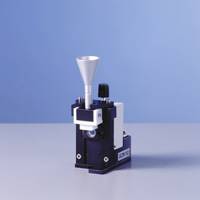 The ACM-108 Micro-Flow Cell
propels liquids through a narrow flow cell for analysis. The liquid is
propelled by an external pump through a narrow cell of 0.5, 1.0, 2.0mm
light-path. Thus particles suspended in heavy or dense media (opaque or
near-opaque liquids) can be analyzed. Recommended for opaque or
near-opaque dispersions when only a small percentage of the laser light
reaches the detector. The ACM-108 Micro-Flow Cell
propels liquids through a narrow flow cell for analysis. The liquid is
propelled by an external pump through a narrow cell of 0.5, 1.0, 2.0mm
light-path. Thus particles suspended in heavy or dense media (opaque or
near-opaque liquids) can be analyzed. Recommended for opaque or
near-opaque dispersions when only a small percentage of the laser light
reaches the detector.
Signal amplification is
optimized by a Calibration Knob. Instructions for calibration are provided
through the software.

|
ACM-110 Microscope
Slide Cell
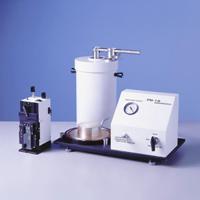 The ACM-110 Microscope Slide
Cell accommodates particles to be analyzed from a standard microscope
slide. The cell motor moves the slide vertically and horizontally,
scanning the sample affixed to the slide. The ACM-110 Microscope Slide
Cell accommodates particles to be analyzed from a standard microscope
slide. The cell motor moves the slide vertically and horizontally,
scanning the sample affixed to the slide.
The ACM-110 Allows a
thin application of material as ink or emulations or as dry state of
measurements such as dispersing inform powder (using PD-10 powder
dispenser system) dispersed on a slide, to be analyzed via a motor that
moves the microscope slide vertically and horizontally across the laser
path. The mechanical motion is designed, so that no area is measured more
than once.

|
ACM-112 Dry Powder
Free Fall Cell
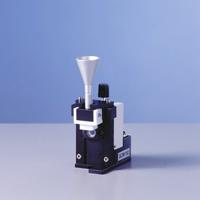 The ACM-112 Free Fall Cell
accommodates analysis of free flowing dry samples. A regulated flow of dry
particles is passed through the cell module. Particle Size and Shape
analysis with both laser and video channels is performed whilst the
particles fall through the system. The ACM-112 Free Fall Cell
accommodates analysis of free flowing dry samples. A regulated flow of dry
particles is passed through the cell module. Particle Size and Shape
analysis with both laser and video channels is performed whilst the
particles fall through the system.
The flow of the particles is
regulated with the PF-101 Dry Powder Feeder.

|
The AC-10 Aerosol Flow
Control Unit is dedicated to supply controlled pressured air and vacuum to
allow optimal sample flow measurement with the ACM-106 Aerosol Flow Cell.
Under suction provided by a
rotary pump in the Aerosol Flow Control Unit, particles flow downward
through the cell. The outlet port is connected by plastic tubing to the
air filter preventing the particles from reaching the reciprocator pump. A
second port on the Flow Control Unit provides a small flow of air to the
side inlet port of the ACM-106. This small air flow creates an “air
sheath” within the flow cell, which prevents particles from adhering to
the walls of the cuvette, and blocking the laser beam.
The user is to generate his
aerosol and feed it to the inlet of the cell for analysis by both laser
and video channel.
The LFC-101 is a pumping unit
providing recirculation and sonication of liquid samples upto 1000 ml.
Both the flow rate and stirrer speed can be adjusted to keep the samples
suspended. The sample is re-circulated through the ACM-104 flow cell using
a peristaltic pump. Dispersion can be promoted by applying
ultrasonics.
The PD-10 is used to disperse
a powder sample uniformly on a microscope slide to be analyzed with the
ACM-110 Microscope Slide Cell. Alternatively, the slide can be analysed
using an optical microscope.
A small quantity of powder is
placed in a well at the top of the cylindrical reservoir of the Powder
Disperser. Vacuum is applied, and with an abrupt trigger, the vacuum seal
is momentarily broken. The sample is instantaneously sucked into the
vacuum reservoir. The abrupt suction creates turbulent flow with high
Reynolds numbers, and high shear forces, causing agglomerates to be
broken, and the particles to be dispersed uniformly in the reservoir
volume. After a short while equilibrium is achieved, as the reservoir has
very low internal forces. Gravitational sedimentation then occurs
simulating the process of isokinetic sampling and the particles form a
uniform monolayer on the slide.
The PF-101, regulates the
smooth flow of dry powder particles enabling Dynamic Shape
Characterization measurement (DSC) and Particle Size Analysis (PSA) in the
EyeTech and in used in combination with ACM-112 Free Fall Cell
The powder is directed into a
thin stream that pours directly into the shape or laser scanning measuring
area of EyeTech Shape Channel. The flow is directed into the field
of view of the video microscope and a video camera captures still pictures
to be used in Shape Analysis. In the EyeTech Laser Channel the flow
is directed to the scanning volume and the computer analyzes the particle
interaction signals. With the PF-101 and the it is possible to
attain rapid and accurate distribution results for a large number of
powder particles. The practical working range for the PF-101 is from 50 um
to 3,6 micron since smaller particle are likely to stay
airborne.
Powders are measured directly
without being dispersed in another medium, therefore they don’t undergo
any alteration. Nor does a medium influence particle distribution.
The PF-101 is simple to
operate, and its precision design means that there is no waste scattering
of particles, the sample material can be recuperated easily. Its
efficiency is especially advantageous regarding costly or toxic
powders. The EyeTech offers complete particle shape analysis on each
particle. Data can be presented individually on each particle (as
statistics) or cumulatively (as distributions). The PF-101 Unit is a
common unit and installation and operation are mentioned in its operation
manual. |
|
|
|
|
|
|
|